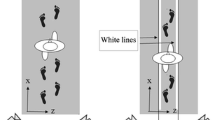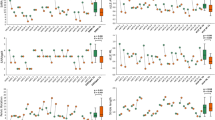Abstract
This study set out to characterise the pattern of planned gait termination in a sample of patients with cerebellar diseases. The gait termination phase was recorded, using a motion analysis system, in ten patients with primary degenerative cerebellar disease and in ten controls. The subjects were instructed to walk at different gait speeds and to stop in response to an acoustic signal. Time–distance parameters (step length, step width, double support duration, time-to-slow, stopping time, centre of mass velocity and number of steps) and stability index-related parameters (distance between the “extrapolated centre of mass” (XCoM) and centre of pressure (CoP)) were measured at both matched and self-selected gait speeds. At matched speed the patients, compared with the controls, showed a reduced step length, a greater first and second step width and used more steps to stop. At self-selected speed, almost all the parameters differed from those of the controls. Furthermore, the patients showed an increased stability index, suggesting that they need to maintain a “safety margin” between the XCoM and CoP during the gait termination. Patients develop a series of compensatory strategies in order to preserve balance during planned gait termination, e.g. increasing their step width and number of steps. Ataxic patients need to maintain a safety margin in order to avoid instability when stopping. Given the potential risk of falls when stopping, walking ataxic patients may benefit from a rehabilitation treatment focused on preserving and improving their ability to terminate gait safely.




Similar content being viewed by others
References
Hase K, Stein RB. Analysis of rapid stopping during human walking. J Neurophysiol. 1998;80:255–61.
O’Kane FW, McGibbon CA, Krebs DE. Kinetic analysis of planned gait termination in healthy subjects and patients with balance disorders. Gait Posture. 2003;17:170–9.
Meier MR, Desrosiers J, Bourassa P, Blaszczyk J. Effect of type II diabetic peripheral neuropathy on gait termination in the elderly. Diabetologia. 2001;44:585–92.
Jian Y, Winter DA, Ishac MG, Glichrist L. Trajectory of the body COG and COP during initiation and termination of gait. Gait Posture. 1993;1:9–22.
Sparrow WA, Tirosh O. Gait termination: a review of experimental methods and the effects of ageing and gait pathologies. Gait Posture. 2005;22:362–71.
Vrieling AH, van Keeken HG, Schoppen T, Otten E, Halbertsma JPK, Hof AL, Postema K. Gait termination in lower limb amputees. Gait Posture. 2008;27:82–90.
Gryfe CI, Amies A, Ashley MJ. A longitudinal study of falls in an elderly population. I. Incidence and comorbidity. Age Ageing. 1977;6:201–10.
Masud T, Morris RO. Epidemiology of falls. Age Ageing. 2001;30:3–7.
Stolze H, Klebe S, Zechlin C, Baecker C, Friege L, Deuschl G. Falls in frequent neurological diseases—prevalence, risk factors and aetiology. J Neurol. 2004;251:79–84.
Bishop M, Brunt D, Marjama-Lyons J. Do people with Parkinson’s disease change strategy during unplanned gait termination? Neurosci Lett. 2006;397:240–4.
Oates AR, Frank JS, Patla AE, VanOoteghem K, Horak FB. Control of dynamic stability during gait termination on a slippery surface in Parkinson’s disease. Mov Disord. 2008;23:1977–83.
Bunday KL, Bronstein AM. Locomotor adaptation and after effects in patients with reduced somatosensory input due to peripheral neuropathy. J Neurophysiol. 2009;102:3119–28.
Morton SM, Bastian AJ. Cerebellar control of balance and locomotion. Neuroscientist. 2004;92:247–59.
Serrao M, Pierelli F, Ranavolo A, Draichio F, Conte C, Don R, Di Fabio R, Lerose M, Padua L, Sandrini G, Casali C. Gait pattern in inherited cerebellar ataxias. Cerebellum. 2011; doi:10.1007/s12311-011-0296-8.
Ferrigno G, Pedotti A. ELITE: a digital dedicated hardware system for movement analysis via real-time TV signal processing. IEEE Trans Biomed Eng. 1985;32:943–50.
Wu G, Cavanagh PR. ISB recommendations for standardization in the reporting of kinematic data. J Biomech. 1995;28:1257–61.
Gutierrez-Farewik EM, Bartonek A, Saraste H. Comparison and evaluation of two common methods to measure center of mass displacement in three dimensions during gait. Hum Mov Sci. 2006;25:238–56.
Davis RB, Ounpuu S, Tyburski D, Gage JR. A gait analysis data collection and reduction technique. Hum Mov Sci. 1991;10:575–87.
Winter DA. Biomechanics of human movement. New York: Wiley; 1979.
Hof AL, Van Bockel RM, Schoppen T, Postema K. Control of lateral balance in walking. Experimental findings in normal subjects and above-knee amputees. Gait Posture. 2007;25:250–8.
Hof AL, Gazendam M, Sinke WE. The condition for dynamic stability. J Biomech. 2005;38:1–8.
Hof AL. The ‘extrapolated center of mass’ concept suggests a simple control of balance in walking. Hum Mov Sci. 2008;27:112–25.
Holmes G. The cerebellum of man. Brain. 1939;62:1–30.
Hallet M, Massaquoi SG. Physiologic studies of dysmetria patients with cerebellar deficits. Can J Neurol Sci. 1993;20 Suppl 3:S83–92.
Morton SM, Bastian AJ. Relative contributions of balance and voluntary leg-coordination deficits to cerebellar gait ataxia. J Neurophysiol. 2003;89:1844–56.
Winter DA. Sagittal plane balance and posture in human walking. IEEE Eng Med Biol Mag. 1987;6:8–11.
Acknowledgements
Special thanks for technical support to David Ranieri and Filippo Sanjust.
Conflict of Interest
Authors declare no conflict of interest or financial interests.
Author information
Authors and Affiliations
Corresponding author
Additional information
Carmela Conte and Mariano Serrao contributed equally to this work.
Rights and permissions
About this article
Cite this article
Conte, C., Serrao, M., Casali, C. et al. Planned Gait Termination in Cerebellar Ataxias. Cerebellum 11, 896–904 (2012). https://doi.org/10.1007/s12311-011-0348-0
Published:
Issue Date:
DOI: https://doi.org/10.1007/s12311-011-0348-0




